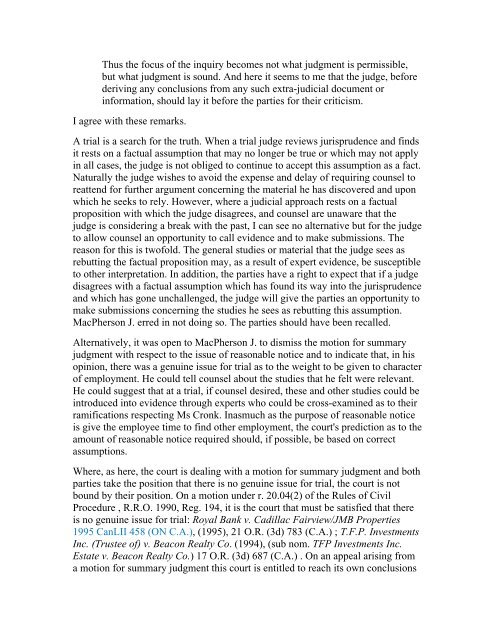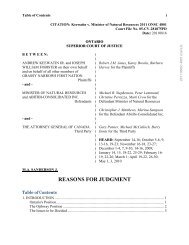Cronk v. Canadian General Insurance Co., 1995 CanLII 814 (ON CA)
Cronk v. Canadian General Insurance Co., 1995 CanLII 814 (ON CA)
Cronk v. Canadian General Insurance Co., 1995 CanLII 814 (ON CA)
You also want an ePaper? Increase the reach of your titles
YUMPU automatically turns print PDFs into web optimized ePapers that Google loves.
Thus the focus of the inquiry becomes not what judgment is permissible,<br />
but what judgment is sound. And here it seems to me that the judge, before<br />
deriving any conclusions from any such extra-judicial document or<br />
information, should lay it before the parties for their criticism.<br />
I agree with these remarks.<br />
A trial is a search for the truth. When a trial judge reviews jurisprudence and finds<br />
it rests on a factual assumption that may no longer be true or which may not apply<br />
in all cases, the judge is not obliged to continue to accept this assumption as a fact.<br />
Naturally the judge wishes to avoid the expense and delay of requiring counsel to<br />
reattend for further argument concerning the material he has discovered and upon<br />
which he seeks to rely. However, where a judicial approach rests on a factual<br />
proposition with which the judge disagrees, and counsel are unaware that the<br />
judge is considering a break with the past, I can see no alternative but for the judge<br />
to allow counsel an opportunity to call evidence and to make submissions. The<br />
reason for this is twofold. The general studies or material that the judge sees as<br />
rebutting the factual proposition may, as a result of expert evidence, be susceptible<br />
to other interpretation. In addition, the parties have a right to expect that if a judge<br />
disagrees with a factual assumption which has found its way into the jurisprudence<br />
and which has gone unchallenged, the judge will give the parties an opportunity to<br />
make submissions concerning the studies he sees as rebutting this assumption.<br />
MacPherson J. erred in not doing so. The parties should have been recalled.<br />
Alternatively, it was open to MacPherson J. to dismiss the motion for summary<br />
judgment with respect to the issue of reasonable notice and to indicate that, in his<br />
opinion, there was a genuine issue for trial as to the weight to be given to character<br />
of employment. He could tell counsel about the studies that he felt were relevant.<br />
He could suggest that at a trial, if counsel desired, these and other studies could be<br />
introduced into evidence through experts who could be cross-examined as to their<br />
ramifications respecting Ms <strong>Cronk</strong>. Inasmuch as the purpose of reasonable notice<br />
is give the employee time to find other employment, the court's prediction as to the<br />
amount of reasonable notice required should, if possible, be based on correct<br />
assumptions.<br />
Where, as here, the court is dealing with a motion for summary judgment and both<br />
parties take the position that there is no genuine issue for trial, the court is not<br />
bound by their position. On a motion under r. 20.04(2) of the Rules of Civil<br />
Procedure , R.R.O. 1990, Reg. 194, it is the court that must be satisfied that there<br />
is no genuine issue for trial: Royal Bank v. Cadillac Fairview/JMB Properties<br />
<strong>1995</strong> <strong>CanLII</strong> 458 (<strong>ON</strong> C.A.), (<strong>1995</strong>), 21 O.R. (3d) 783 (C.A.) ; T.F.P. Investments<br />
Inc. (Trustee of) v. Beacon Realty <strong>Co</strong>. (1994), (sub nom. TFP Investments Inc.<br />
Estate v. Beacon Realty <strong>Co</strong>.) 17 O.R. (3d) 687 (C.A.) . On an appeal arising from<br />
a motion for summary judgment this court is entitled to reach its own conclusions
















